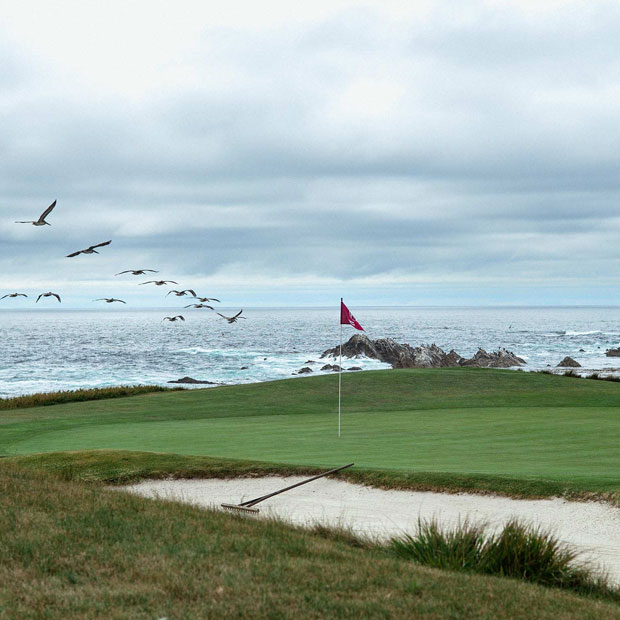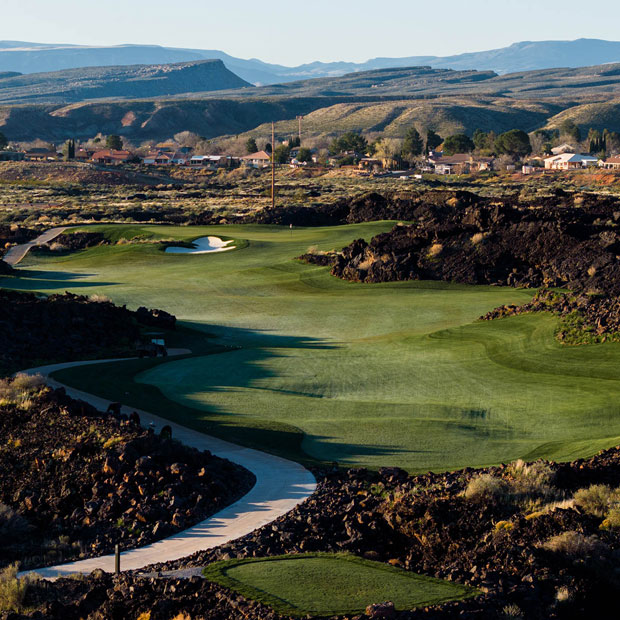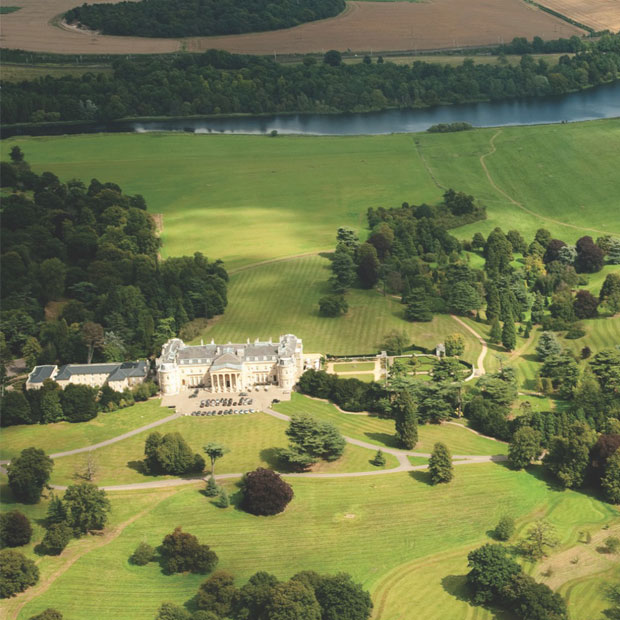Lahinch Golf Club (Old Course)
Lahinch Golf Club is a sort of religious experience—captivating raw dune golf, a surfing-centric village almost contiguous with the course, and goats tottering around the property

Lahinch, County Clare, Ireland
Old Tom Morris (redesign, 1894), Charles Gibson (1907), Alister MacKenzie (1926), Donald Steel (1984-1987), Martin Hawtree (1999)
Semi-Private
$$$
You're Invited to Fried Egg Golf Club's 2026 International Trips
Lahinch Golf Club for many visitors is a sort of religious experience—captivating raw dune golf, the surfing-centric village (almost contiguous with the course), and the goats tottering around the property. Catch Lahinch on a good summer’s day and you’ll be converted for life.
The first game at Lahinch was played on Good Friday in April 1892. The club had been set up by Alexander Shaw, a member of Limerick Golf Club (1891). In 1894, Shaw brought in Old Tom Morris to improve the rudimentary layout, which had 10 holes on flatter land now occupied by the club’s Castle Course and eight holes on the current sandhills site of the main course, known as the Old Course. One of the only recognizable holes from this layout is the world-famous blind par-3 fifth, the “Dell” hole, which is oft-proferred as an Old Tom creation yet a dearth of evidence supports this. More certain is that Old Tom brought the equally well-known “Klondyke”—the short par-5 fourth hole with a blind second shot over a heroic hill—into being in 1897.
In the mid-1920s, Alister MacKenzie left his indelible mark on Lahinch by radically altering many basic greens into rollicking plateau putting surfaces with enough intrigue to make attack angles and tee-shot placement a real consideration. He designed holes 11-13 in their entirety, and although his par-3 11th has been eschewed in favor of a new par 3 built by Martin Hawtree in the early 2000s, the MacKenzie 11th still exists as an alternate hole. Lahinch, through reasons of erosion and continual work, now only has a handful of original MacKenzie greens left, yet the Good Doctor’s influence is still pervasive through the links.
Editor’s note: This profile was written by Darragh Garrahy, who previously profiled Portmarnock Golf Club. To ensure an objective final review, the Fried Egg Golf team alone was responsible for the final Egg rating and reasoning.
{{content-block-course-profile-lahinch-golf-club-old-course-001}}
Take Note…
Cypress Hill (man). The writer of this piece grew up on a steady diet of west coast rap music in the 1990s, with California group Cypress Hill being a favorite. The Walker Cup will return to California next year, at Cypress Point, and then make a first visit to Lahinch in 2026. I couldn’t think of two better match play courses for these back-to-back iterations to showcase the purest form of the game. The duality of the two courses’ visuals and environment is stark in many ways, but both pull their strategy from the same genius of MacKenzie. A “Hill man” may have a very different meaning to Cali rappers, but in Lahinch he ensures golfers’ safety at the Klondyke hole (the 18th at Lahinch crosses Klondyke). A shrewd golfer will crest the hill, greet the Hill man and look to see where the flag is on the upcoming Dell.
King of the Castle. The Castle Course at Lahinch is an underrated second course sitting on flat but firm land. With the harsh climate on the west coast of Ireland, Lahinch usually closes the Old Course for 4-6 weeks each January/February to rest before heavy visitor play from April until October. Having an improved Castle Course as a release valve for members and visitors alike would be a boon. I expect Lahinch will move to improve the already very enjoyable Castle Course in the near future.
The King of Lahinch. The Irish are obsessed with elite amateur golf, and in particular match play. The four regions in Ireland each have their own championship for good amateurs: the North, South, East, and West. They are played at Royal Portrush, Lahinch, County Louth (Baltray), and County Sligo (Rosses Point), respectively. The week-long carnival of match play golf at “The South” is the longest-running, originating in 1895. Lahinch local John Burke won the title eleven times between 1928 and 1946 and didn’t even enter from 1932-1937 as his dominance was causing others not to play. He was known as the ”King of Lahinch” and I’m sure he would have enjoyed seeing The South won by an American for the first time in 2024 (Patrick Adler, Chicago).
Favorite Hole
No. 13, par 4, 279 yards
The contrast between the 12th and the following green on the drivable par-4 13th is stark. Green morphology is somewhat similar on both holes, but contours tie in much better on the 13th, particularly on the front left, as seen in this picture by Riley Johns.
Favorite Hole
No. 13, par 4, 279 yards
The contrast between the 12th and the following green on the drivable par-4 13th is stark. Green morphology is somewhat similar on both holes, but contours tie in much better on the 13th, particularly on the front left, as seen in this picture by Riley Johns.

Nor is the entrance as choked on No. 13 as on No. 12; the 13th green bleeds out of the dune behind it gently with neither dominating competition for your eye in perfect harmony. A central hillock short of the green poses a challenge for the better player trying to fly it onto the green, but won’t trouble the average golfer who will hit before the hillock, then over it. Take note, short-right bunkers on No. 12!

{{content-block-course-profile-lahinch-golf-club-old-course-002}}
Overall Thoughts
Lahinch Golf Club has the best set of par 4s in Ireland and it’s not even close. I’m going to take you on a tour viewed primarily through the lens of these class-act two-shotters.
The first offers a wide expanse for a tee shot. The approach shot up a gentle hill is a short iron to a green where you won’t be able to see the base of the flag and can fall off on three sides. There’s nothing to be done to the first at Lahinch that could make it a better opener. The third requires a good carry over a hill off the tee and then a strong approach to carry broken ground that connects the end of the fairway at 300 yards and the green.
Hired in 1907, Charles Gibson had increased the number of holes on the sandhills to 13 (MacKenzie got all 18 to the sandhills in 1928). In doing so Gibson created the current sixth and seventh holes in previously unused dunes. The sixth is iconic with its awe-inspiring backdrop of the green set against the Atlantic Ocean. A pot bunker lies in the middle of the fairway, set in a deep hole that used to take the form of a much larger, less steep, and rougher-hewn bunker which a player could attempt to go for the green from, offering the chance at epic heroism or failure. The sixth green was relocated in the 1980s by Donald Steel and is a touch narrow for the demands of the approach shot, especially when paired with the steep slopes on the right of the green. This combination takes some of the strategy out of the approach—only a high, straight shot hitting the middle of the green will do. The vista behind the sixth green is dramatic but the slopes coming off the green match it, unnecessarily. The redesign of the green, to me, is an example of the phrase to “gild the lily”—a more demure green and surrounds might pronounce, all the more, the brilliance from the tee-to-green edge that comes before.

The seventh runs along the coastline, and like the third, asks the player to hit over broken ground, but this time to a green flush against the coastline. Titillating golf indeed but the first, third, sixth, and the upcoming ninth holes all push the seventh into the bottom tier of front nine par 4s, underscoring the astonishing overall quality.

The front nine closer is a straight par 4 playing between 370-390 yards with a ridge running diagonally from right to left through the fairway; if you can get it over this ridge you’ll have a flip wedge remaining. It might look from the tee like the portion of the fairway over the ridge on the right will offer a better (and shorter) second shot but the right-hand side of the green is essentially the side of a hill, which will kick everything left. It’s imperative to approach the green from the left—not much point in clearing the ridge with your drive if you do it on the right side.
The hits keep on coming at Lahinch—the 10th and 15th are long, uphill par 4s that move a little right to left, playing in the same direction (the 14th sits between them). They play 430 and 450 yards, respectively, and usually into a left-to-right crosswind. Reading back on the substance of these par 4s at Lahinch you will notice undoubted quality and variety, but also difficulty. This must be explained in the context of gettable par 5s at the second, fourth, 12th, and home hole 18th. The fourth and 12th holes can play short with a prevailing wind while the 18th is wide, playing in the same corridor as the first.
The 12th green was relocated to protect against erosion at the same time as the sixth green was moved and suffers from a similar problem; this frequently downwind par 5 culminates in a very narrow green with balls easily tumbling off the front left and right. There is little tie-in between the slopes coming off the green and the surrounding land. Rather the slopes lead to small constricted collection points. A running shot is precluded by two further bunkers in close proximity to the green, short and right.
The finishing stretch at Lahinch of Nos. 16-18 does not match the highs of the first 15, but that’s okay. It allows us to take a breath on our walk down the 17th and 18th, which run along the road separating the two courses.
A quick story, though, about the 18th, which is far from my favorite hole—a par 5 that tracks along a boundary OB wall the whole way to the green. There is no line of charm off the tee; one can bail out right on the second shot, away from the OB, and be fine.
A few years ago, a very good player from my club was cruising into matchplay in the South of Ireland Championship, four or five under on his round. Oddly, he pulled metal in the 18th fairway and hit his second shot over the wall left, OB. He made a 7 and barely qualified. Another clubmate, a witness to this, asked him why he did it. He responded with a shrug: “If you don’t go, you’ll never know.” This comment gains more meaning the more you think about it. A good player knows you have to capitalize on a heater when you get one. Golf is a game of calculated risk, and indeed most regrets in life pertain to chances not taken.
I still don’t love the 18th at Lahinch, nor do I like boundary OB and binary hazards that offer no chance for recovery. But Lahinch is a club that exists almost inside a town, and its walls are a real part of the DNA. And “if you don’t go (to Lahinch), you’ll never know” what awaits.

Lahinch Golf Club is a sort of magical place with its mesh between village and course, members and visitors. Lahinch for me doesn’t get enough play on the subtlety and strength of its par 4s, so I’ve chosen to shine a light on them. I haven’t even described Klondyke and Dell, holes that garner so much press. If you want to study them, sit with the Hill man and see them for yourself. Maybe at the Walker Cup in 2026 when some very good amateurs will show what Lahinch is best for – match play and fun.
3 Eggs
Like many of the great links courses, there is a level of acceptance that must be exercised at Lahinch. The first nine is fraught with blindness – remnants of Old Tom’s original work – while the course’s finish lacks the punch of the earlier holes. Embracing these traits instead of fighting them allows the course to reveal itself, and what’s left is a collection of some of the most thrilling shots in the sport on one of the most naturally gifted sites in the world. Lahinch’s quirks are what make it unique and its connection to the town is really only rivaled by St. Andrews. As a pure golf experience, Lahinch is as good as it gets. — Cameron Hurdus
Course Tour

{{content-block-course-profile-lahinch-golf-club-old-course-003}}
Additional Content
Ooh la Lahinch (Article)
The land of 10,000 man-made lakes and links season begins at Lahinch (Shotgun Start podcast)
Leave a comment or start a discussion
Get full access to exclusive benefits from Fried Egg Golf
- Member-only content
- Community discussions forums
- Member-only experiences and early access to events

















Leave a comment or start a discussion
Lorem ipsum dolor sit amet, consectetur adipiscing elit. Suspendisse varius enim in eros elementum tristique. Duis cursus, mi quis viverra ornare, eros dolor interdum nulla, ut commodo diam libero vitae erat. Aenean faucibus nibh et justo cursus id rutrum lorem imperdiet. Nunc ut sem vitae risus tristique posuere. uis cursus, mi quis viverra ornare, eros dolor interdum nulla, ut commodo diam libero vitae erat. Aenean faucibus nibh et justo cursus id rutrum lorem imperdiet. Nunc ut sem vitae risus tristique posuere.